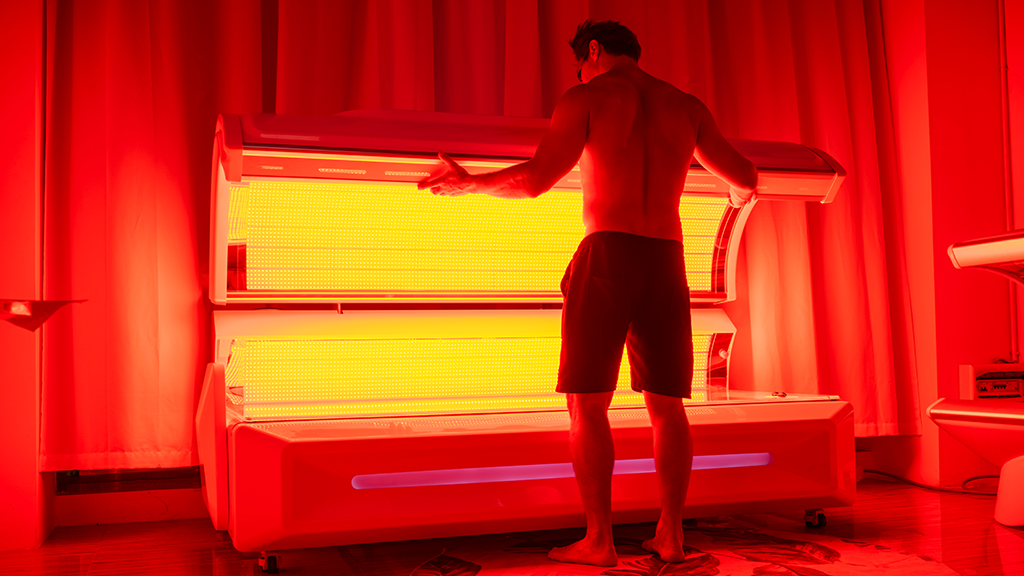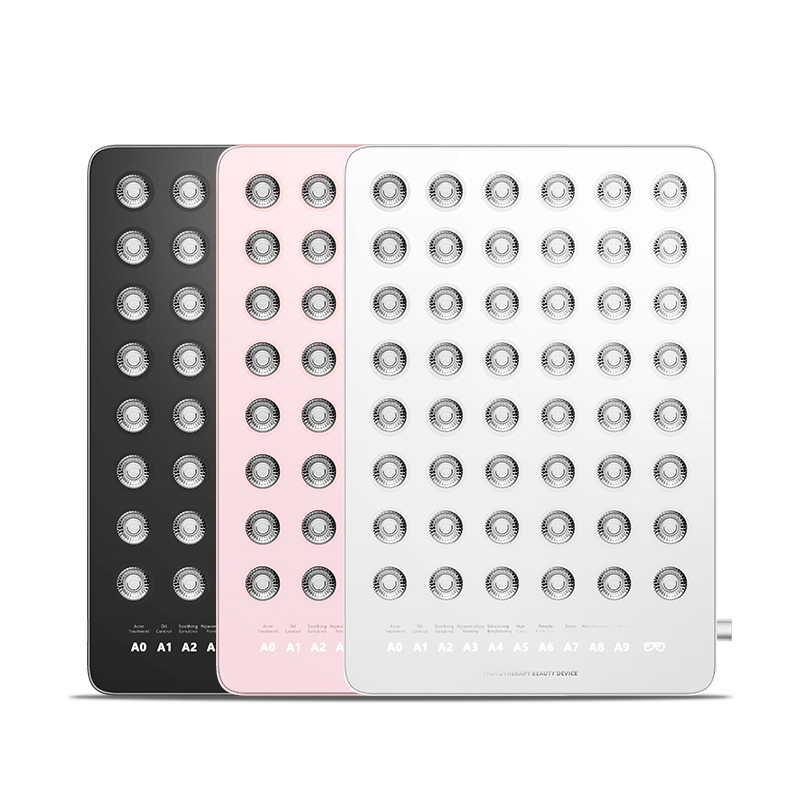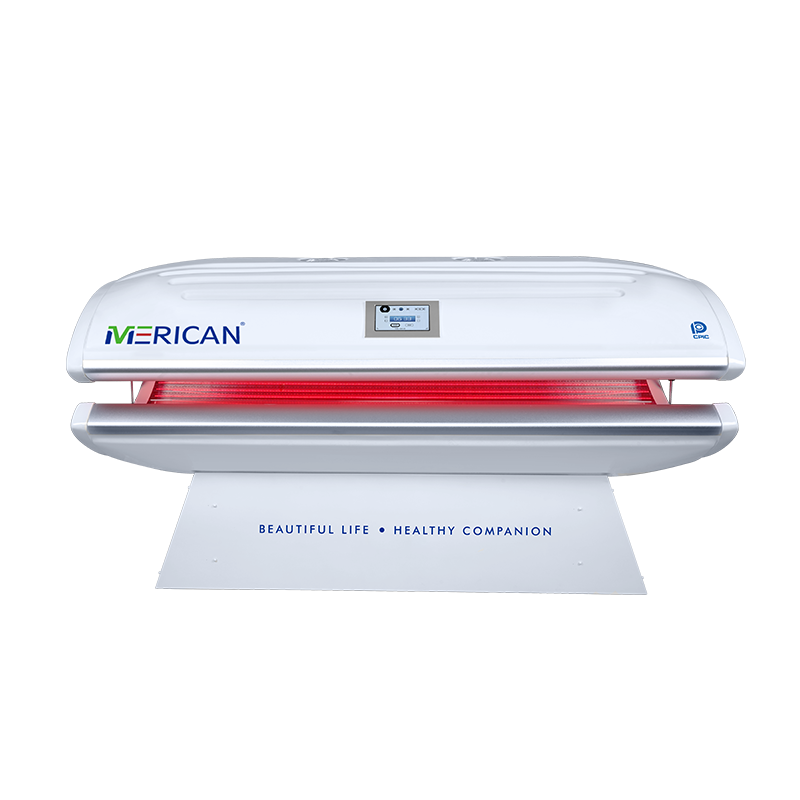Rotlichttherapie nutzt die einzigartigen Eigenschaften bestimmter roter Wellenlängen (sichtbar) und fast infrarot (unsichtbar) Licht zur Förderung des Wohlbefindens. Menschen nutzen die Rotlichttherapie für verschiedene Zwecke, einschließlich der Umkehrung der Hautalterung, die Wundheilung verbessern, das Energieniveau steigern, Entzündungen reduzieren, Verbesserung der Gelenkgesundheit, und besser schlafen.
Die Wirkungsweise der Rotlichttherapie ist noch Gegenstand laufender Forschung. Viele Studien haben gezeigt, dass die Rotlichttherapie verschiedene potenzielle Vorteile hat und dass der Einsatz der Rotlichttherapie eine sichere und schmerzlose Möglichkeit sein kann, gesundheitliche Vorteile zu erzielen.
Es ist bekannt, dass die bloße Anwesenheit von Licht unsere Biologie auf vielfältige Weise beeinflusst. Schlafhormone werden durch die Lichtmenge reguliert, die in unsere Augen eindringt. Licht beeinflusst, wie viel Pigmentierung unsere Haut produziert. Bestimmte Lichtwellenlängen regen unseren Körper auch zur Bildung von Vitamin D an. Bei einigen Neugeborenen wird Licht zum Abbau einer Chemikalie namens Bilirubin eingesetzt und zu diesem Zweck in Krankenhäusern auf der ganzen Welt eingesetzt. Mit energiereichem Licht können auch Bakterien abgetötet und Oberflächen desinfiziert werden.
Bei der Rotlichttherapie werden bestimmte Lichtwellenlängen verwendet, die länger sind als andere Lichtfarben. Rotes Licht und Licht im nahen Infrarot können tiefer in Körpergewebe eindringen als andere sichtbare Lichtwellenlängen und Gewebe erreichen, die diese anderen Wellenlängen nicht erreichen.
Einer der potenziellen Vorteile der Rotlichttherapie ist ein verbesserter Schlaf. Die Rotlichttherapie wird seit vielen Jahren zur Förderung des Schlafes eingesetzt, Doch erst vor Kurzem hat die Forschung damit begonnen, zu untersuchen, welche Vorteile die Rotlichttherapie bietet und wie sie den Schlaf fördert.

Schlafen
Schlaf ist ein wesentlicher Bestandteil der Gesundheit. Wir berücksichtigen oft nicht die Auswirkungen des Schlafes, Aber die meisten Menschen verbringen im Laufe ihres Lebens mehr Zeit mit Schlafen als mit jeder anderen Aktivität. Wer regelmäßig die empfohlenen acht Stunden pro Nacht schläft, verbringt ein Drittel seines Lebens schlafend.
Trotz der hohen Bedeutung des Schlafes, Der genaue biologische Zweck, dem es dient, ist immer noch ein medizinisches Rätsel. Es hat sich gezeigt, dass Schlaf neurologische Bahnen in Ihrem Gehirn bildet und aufrechterhält, damit Sie klarer denken können, sich besser konzentrieren, und haben ein besseres Gedächtnis. Es hat sich auch gezeigt, dass Schlaf Giftstoffe entfernt, die sich tagsüber in Ihrem Gehirn ansammeln.
Schlafzyklen
Es gibt zwei grundlegende Arten von Schlaf, die jeder hat. Diese beiden Schlafarten treten in Zyklen auf und beinhalten schnelle Augenbewegungen (REM) Schlaf und Non-REM-Schlaf.
Der Non-REM-Schlaf verläuft in drei Phasen:
Bühne 1: Diese Schlafphase ist der Übergang vom Wachzustand in den Schlaf. Die Gehirnwellen beginnen von einem aktiven Stadium in einen langsameren Schlafzustand überzugehen.
Bühne 2: Während der zweiten Schlafphase, Ihre Gehirnwellen verlangsamen sich noch mehr. Deine Augen hören auf, sich zu bewegen, Ihr Herzschlag und Ihre Atmung sind langsam, und Ihre Körpertemperatur sinkt.
Bühne 3: Im tiefsten Schlafstadium werden die Gehirnwellen noch langsamer. Ihr Körper wird sehr entspannt, und es wäre schwierig, in diesem Stadium aufzuwachen. Diese Schlafphase spielt eine große Rolle dabei, dass Sie sich morgens erfrischt fühlen.
Der REM-Schlaf tritt in regelmäßigen Abständen auf, während Sie zwischen den Phasen des Nicht-REM-Schlafs schlafen. Je länger Sie schlafen, desto länger und tiefer sind die REM-Schlafphasen. Der REM-Schlaf ist das Schlafstadium, in dem Träume auftreten. Der REM-Schlaf tritt häufiger auf, je näher der Morgen rückt, und ist die Schlafform, die dem Wachzustand am nächsten kommt.
Zirkadianer Rhythmus
Der zirkadiane Rhythmus ist der Gesamtzyklus, den Ihr Körper in einem Zeitraum von etwa 24 Stunden durchläuft. Zwar gibt es viele wichtige biologische Funktionen, die der zirkadiane Rhythmus beeinflusst, Schlaf ist einer der wichtigsten. Der zirkadiane Rhythmus synchronisiert sich mit dem Licht, fördert den Schlaf, wenn die Lichtverhältnisse sinken.
Der Einfluss von Licht auf den zirkadianen Rhythmus ist gut belegt, und die Wissenschaft hat bewiesen, dass Lichteinwirkung unmittelbar vor dem Zubettgehen den Schlaf stören kann. Kürzlich, Es ist besser zu verstehen, dass die Wellenlänge des Lichts dabei eine wesentliche Rolle spielt. Blaues Licht, das eine höhere Energie und eine kürzere Wellenlänge hat, Es wurde gezeigt, dass es Melatonin unterdrückt, a hormone that the circadian rhythm uses to promote sleep.
The negative effects of blue light on sleep are so impactful that smartphone makers have recently begun providing settings that can automatically reduce the amount of the blue, high energy light that your phone generates. People use these settings to reduce exposure to high-energy light at night and to sleep more soundly.
Sleep Disturbances
While sleep is regenerative and essential to good health, sleep disturbances can have a profound negative effect. Chronic lack of sleep has been connected to many health problems, einschließlich:
High blood pressure
Heart disease
Diabetes
Depression
Obesity
People who struggle to get to sleep or have chronic sleep problems have a higher risk of disease when compared to those who sleep well and may have long-term health problems that could otherwise be avoided.
Does Red Light Therapy Help Sleep?
Red light therapy uses specific wavelengths of red and NIR light to help rejuvenate cells and promote overall health. One of the popular uses of red light therapy is to help people have better sleep quality.
While the use of red light therapy to promote sleep health is a newer technology, there are several studies that have shown benefits to using red light therapy. One of the first studies to examine this use of red light therapy technology examined the impact that it had on a group of elite female basketball players. In dieser Studie, the players were divided into two groups. One group was not given any red light therapy, while the other group was given full-body red light therapy for 30 minutes every night for two weeks.
The researchers then evaluated the athletic performance of the two groups, the quality of their sleep, and the levels of melatonin in their blood. Researchers found that the physical endurance of the group that received red-light therapy had improved more than the group that had not. The group that received the red light therapy also reported that the quality of their sleep improved after two weeks of therapy. The levels of melatonin in the blood of those who received the red light therapy were also significantly higher than those who did not receive the red light therapy.
In addition to multiple small studies showing that red light therapy has positive effects on sleep quality, many people anecdotally report that the use of red light therapy helps them sleep better and feel more refreshed after waking up.
While there have been several small studies that show promise in this area, scientists have not yet performed any of the large-scale studies needed to conclusively prove the benefits of red light therapy for sleep. Jedoch, even though a large-scale study has not yet been run, the early indicators that smaller studies and anecdotal evidence provide show meaningful benefits and that a larger study would likely show widespread positive sleep benefits from red light therapy.
How Does Red Light Therapy Promote Sleep
Während erste Studien zur Rotlichttherapie zeigen, dass sie zu einem besseren Schlaf beiträgt, Die Frage, wie dies geschieht, ist eine Frage, mit der Wissenschaftler gerade erst beginnen.
Eine Gruppe von Forschern, unter der Leitung des Forschers Dr. Ronnie Yeager, veröffentlichten einen wichtigen Artikel, in dem sie ihre wissenschaftliche Hypothese darlegten, wie die Rotlichttherapie den Schlaf verbessert. Diese Hypothese basiert auf dem Hormon Melatonin. Melatonin spielt eine entscheidende Rolle bei der Regulierung des Tagesrhythmus und der Förderung des Schlafes. Blaues Licht senkt nachweislich den Melatoninspiegel, Dies ist der Hauptgrund dafür, dass blaues Licht die Wachsamkeit fördert.
Die Forscher lieferten Erkenntnisse darüber, wie die Rotlichttherapie mit Zellen interagieren könnte, Erhöhung des Melatoninspiegels. Sie erläuterten auch mögliche Mechanismen, die erklären, wie die Wechselwirkung der Wellenlängen des roten Lichts mit Melatonin auch einige der anderen gesundheitlichen Vorteile von rotem Licht erklären könnte, die bisher nicht gut verstanden wurden.
Wenn die von diesen Forschern aufgestellte Hypothese richtig ist, durch die Stimulierung von Melatonin, Eine Rotlichttherapie könnte die Einschlafphase fördern und dazu beitragen, dass der Schlaf nach dem Einschlafen länger anhält. Zur Verifizierung dieses ersten Modells sind jedoch weitere Untersuchungen erforderlich, Die grundlegenden Konzepte dieser Forschung erklären intuitiv, wie die Rotlichttherapie den Schlaf effektiv fördern würde.
Schnelle Tipps für besseren Schlaf
Wie können wir dies alles in einige praktische Maßnahmen zusammenfassen, die Sie ergreifen können, um besser zu schlafen??
Hier sind einige Vorschläge:
1) Beginnen Sie den Tag, indem Sie sofort nach draußen in die Sonne gehen, um „neu zu starten“.’ Ihre zirkadiane Uhr. Es hat sich gezeigt, dass Sonneneinstrahlung am frühen Morgen den Schlaf verbessert.
2) Wenn möglich, Gehen Sie den ganzen Tag über regelmäßig in die Sonne. Wie in diesem Artikel aus Oxford besprochen, Die Qualität und Architektur des Schlafes hängt von der vorangegangenen Lichtexposition ab.
3) Vermeiden Sie den Konsum von Koffein nach Mittag.
4) Versuchen Sie es mit a MERICAN empfehlen Rotlichttherapiebett M6N mindestens 2-3 Mal pro Woche.
5) Reduzieren Sie abends das helle Umgebungslicht, indem Sie sich für einige bernsteinfarbene/orangefarbene/rote Glühbirnen entscheiden.
6) Vermeiden Sie außerdem blaues/grünes Licht am Abend, indem Sie eine Blaublocker-Brille tragen.
7) Verwenden Sie Programme wie Iris und/oder F.Lux, um das blaue/grüne Licht von Computer-/Tablet-/Smartphone-Bildschirmen automatisch zu reduzieren. Verwenden Sie driftTV, um blaues Licht vom Fernseher zu entfernen.
8) Verwenden Sie Verdunklungsvorhänge, um die Lichtverschmutzung zu reduzieren’ im Schlafzimmer von außen.
Diese einfachen Tipps sollen Ihnen dabei helfen, Ihre helle Umgebung ganz einfach zu nutzen, um mit Ihrer Biologie zusammenzuarbeiten und so einen besseren Schlaf zu fördern!

























